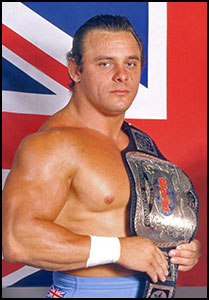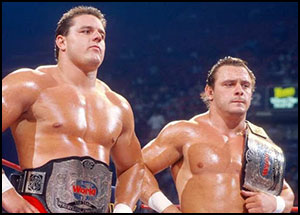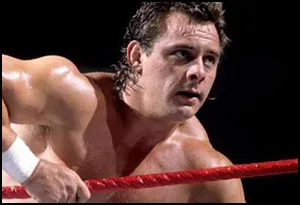by Stephen Von Slagle
Tom Billington, known across the globe as The Dynamite Kid, was a world-traveler who wrestled frequently on his home continent of Europe, as well competing extensively in Canada, the U.S. and Japan. His talent was known far and wide, even before he gained mainstream fame along with cousin Davey Boy Smith as part of The British Bulldogs during the WWF’s explosion of popularity in the mid-1980s. In the ten years he wrestled prior to entering the World Wrestling Federation, Tom Billington clearly established himself as one of, if not the top, Junior Heavyweight in the world. His style, and execution of particular moves (such as the Snap-Suplex and Flying Headbutt) has been an inspiration for numerous wrestlers, including many heavyweights. The supremely conditioned Dynamite Kid’s technique of incorporating impressive, high-flying moves with a truly dangerous and equally exciting mat attack also had a huge influence on his Japanese audience, which included many future Cruiserweight and Heavyweight superstars. Be it North America, Europe or Japan, The Dynamite Kid helped keep the Junior Heavyweight-Light Heavyweight-Cruiserweight division alive during a very trying time for the lighter weight class. Without The Kid’s incredible talent and ability to draw interest and live audiences, the high-flyers of today would not have such a comfortable place in the current wrestling product.
 Tom Billington was born on December 5, 1958 in Golborne, England. After meeting former wrestler Ted Betley, who encouraged him to give the sport a try, he began his training under Betley at the age of just 13 years old. Seeing his natural talent, Betley brought the young Billington to Riley’s Gym in Wigan, a place well-known as the toughest shooter training ground in England. After being brutalized at “The Snake Pit” and, eventually, learning how to reciprocate that punishment, in 1975 the teenager began his career as a professional wrestler in the gritty, underground world of the British independent scene. Despite his small stature, (during this time period, the 5’8″ Billington weighed considerably less than 200 lbs.) he quickly earned a reputation throughout the country as being a legitimate future star. The Dynamite Kid’s explosive timing and high-impact repertoire lived up to his ring moniker, resulting in championship after championship once he joined the Crabtree brothers’ Joint Promotions. He was initially paired with the promotion’s top star, “Big Daddy” Shirley Crabtree, and the two combined for an entertaining “David and Goliath” team. A hit with the fans, at the age of 18 he became the youngest British Lightweight champion in history when he defeated Jimmy Breaks in 1977 and then, in 1978, he toppled Bobby Ryan to become the British Welterweight champion.
Tom Billington was born on December 5, 1958 in Golborne, England. After meeting former wrestler Ted Betley, who encouraged him to give the sport a try, he began his training under Betley at the age of just 13 years old. Seeing his natural talent, Betley brought the young Billington to Riley’s Gym in Wigan, a place well-known as the toughest shooter training ground in England. After being brutalized at “The Snake Pit” and, eventually, learning how to reciprocate that punishment, in 1975 the teenager began his career as a professional wrestler in the gritty, underground world of the British independent scene. Despite his small stature, (during this time period, the 5’8″ Billington weighed considerably less than 200 lbs.) he quickly earned a reputation throughout the country as being a legitimate future star. The Dynamite Kid’s explosive timing and high-impact repertoire lived up to his ring moniker, resulting in championship after championship once he joined the Crabtree brothers’ Joint Promotions. He was initially paired with the promotion’s top star, “Big Daddy” Shirley Crabtree, and the two combined for an entertaining “David and Goliath” team. A hit with the fans, at the age of 18 he became the youngest British Lightweight champion in history when he defeated Jimmy Breaks in 1977 and then, in 1978, he toppled Bobby Ryan to become the British Welterweight champion.
After rising to the top in Joint Promotions, The Kid accepted an invitation from a visiting Bruce Hart to work in North America, specifically, for his father Stu Hart’s Calgary-based Stampede Wrestling group. The regional Canadian promotion had a reputation for giving Junior Heavyweights a fair shot and was known as a great training ground for up-and-coming wrestlers. The Dynamite Kid brought his unique European style and integrated it with the traditional mat-based style of the Stampede wrestlers. The result was something that was exciting, believable, and very popular with the fans. While in the Stampede promotion, The Kid captured the British Commonwealth Mid-Heavyweight title (twice) in 1978 and the World Mid-Heavyweight title in 1979. It was as Stampede World Mid-Heavyweight champion that he began wrestling as a heel and started a bitter feud with a young Bret Hart, a feud that traversed the entire Calgary territory. In 1980, he continued his rivalry with the Harts by teaming with Luke McMasters, and later, Kasavudu to defeat Keith and Bret Hart for the Stampede International Tag Team title. Billington also won the International Tag Team title with Duke Myers in 1982, this time defeating Bret Hart & Leo Burke.
 Billington’s success was even greater in Japan than in Canada. In the Land of the Rising Sun, The Dynamite Kid was a genuine top-level superstar within the brand-new and highly popular I.W.G.P. Junior Heavyweight division during its formative years in the early 1980s. So, when the heavily-favored Kid was upset by the debuting (and soon to be legendary) Tiger Mask on January 1, 1982, it created major shockwaves within NJPW The historic feud between Tiger Mask and The Dynamite Kid was truly as innovative, exciting and trend-setting as anything taking place in the world of pro wrestling at that time and their classic matches laid the groundwork for a style of wrestling that continues to this day.
Billington’s success was even greater in Japan than in Canada. In the Land of the Rising Sun, The Dynamite Kid was a genuine top-level superstar within the brand-new and highly popular I.W.G.P. Junior Heavyweight division during its formative years in the early 1980s. So, when the heavily-favored Kid was upset by the debuting (and soon to be legendary) Tiger Mask on January 1, 1982, it created major shockwaves within NJPW The historic feud between Tiger Mask and The Dynamite Kid was truly as innovative, exciting and trend-setting as anything taking place in the world of pro wrestling at that time and their classic matches laid the groundwork for a style of wrestling that continues to this day.
While in New Japan, Billington won the WWF World Junior Heavyweight title on February 7, 1984 and in 1985, after jumping to All Japan Pro Wrestling, he captured the NWA International Junior Heavyweight title. At the same time, back in Calgary, The Kid was squaring off in a heated feud with the young man who would soon accompany him to unforeseen fame, Davey Boy Smith. Billington and Smith, cousins, were intense rivals prior to their legendary tag team and the two Junior Heavyweights (the heavily-muscled Smith was much smaller during this period of time, as was The Kid) wrestled in cities all across the Stampede territory in a feud that thrilled fans and drew impressive crowds for Stampede. However, when they put their storyline differences aside and formed a tag team, the careers of both men skyrocketed to new heights.
The British Bulldogs are generally thought of as one of the greatest tag teams of the late twentieth century, and their combination of precise teamwork, agility, stealth and power was a model for all other tag teams, both in North America and Japan. While their one WWF World Tag Team title reign lasted just nine months (a relatively short reign for that period of time) the team made a profound impact during their three-year stay in the WWF, as well as during their tours of both New Japan and All Japan. Although their pure wrestling ability was often overshadowed by the cartoonish aspect of the wrestlers who made up the WWF roster during the mid-1980s, the Bulldogs’ incredible ring work consistently made fans notice them, until the promotion had no choice but to give them a title run. The British Bulldogs were an exemplary tag team and true crowd-pleasers that the WWF’s bookers could always count on to deliver a high-quality match. Unfortunately for most of the WWF’s roster of one-dimensional giants in the mid 1980s, going on after The Bulldogs could (and did) expose their lack of ring technique to the fans, who, after being blown away by the intensity and skill of a Bulldogs vs. Hart Foundation battle, would often sit on their hands during other matches on the card.

So, when the British Bulldogs abruptly left the WWF in 1988, returning “home” to Stampede Wrestling, the move from the World Wrestling Federation to Stampede was a bit of a shock to wrestling fans. After all, the WWF was at the height of its fame and power, and Stampede Wrestling, while respected, drew crowds that often would not exceed even 1,000 people. What fans didn’t realize at the time was that behind the scenes at the WWF, the abrasive, short-tempered Billington had burned many bridges with both wrestlers and front office personnel, making his exit inevitable. Nevertheless, the world famous British Bulldogs returned to the Calgary mat wars, as well as travelling to the AWA’s Central States promotion (after the territory had withdrawn from the NWA) to take on The Rock `N Roll Express in what was billed as a tag team “dream match.” The former respective NWA and WWF World Tag Team champions never really settled the question of who was the better team, but their brief mini-feud was still a independent wrestling highlight of the late 1980s.
 Back in Calgary, Smith and Billington had a bitter falling out that saw The Kid not only turning his back on his cousin and longtime partner, but also his loyal fans. As the story developed, Davey Boy’s cousin Johnny Smith was recruited into the war by The Kid, and they formed The British Bruisers. The Billington vs. Smith feud was shaping up to be the main attraction of Stampede for the foreseeable future, however, Davey Boy was unexpectedly involved in a serious car wreck which took him out of the picture for quite some time, effectively ending their feud before it really got started. In many ways, Stampede’s Bulldog vs. Bulldog program was a storyline portrayal of the real-life personal and professional conflicts that slowly developed between the longtime partners. Their bitter falling-out sadly resulted in the cousins (and their respective families) refusing to speak to each other for over twenty years and, regrettably, Smith passed away before a reconciliation between the two could take place.
Back in Calgary, Smith and Billington had a bitter falling out that saw The Kid not only turning his back on his cousin and longtime partner, but also his loyal fans. As the story developed, Davey Boy’s cousin Johnny Smith was recruited into the war by The Kid, and they formed The British Bruisers. The Billington vs. Smith feud was shaping up to be the main attraction of Stampede for the foreseeable future, however, Davey Boy was unexpectedly involved in a serious car wreck which took him out of the picture for quite some time, effectively ending their feud before it really got started. In many ways, Stampede’s Bulldog vs. Bulldog program was a storyline portrayal of the real-life personal and professional conflicts that slowly developed between the longtime partners. Their bitter falling-out sadly resulted in the cousins (and their respective families) refusing to speak to each other for over twenty years and, regrettably, Smith passed away before a reconciliation between the two could take place.
Although Davey Boy Smith would go on to have a long career that would see him gain solo success in both the WWF and WCW, Tom “The Dynamite Kid” Billington’s storied career was about to end. After fifteen years in the ring, employing his high-impact, daredevil style, The Kid was simply no longer the wrestler he had once been. The years of injuries, surgeries and abuse of his body finally took their toll and Billington’s back was simply too battered to continue wrestling. Regrettably, the career of one of the greatest Junior Heavyweight and Tag Team wrestlers in the history of the sport was forced to come to a premature end. Eventually, Billington became essentially bed-ridden and wheel chair-bound, partially paralyzed due to complications from a series of injuries.
 Fittingly, The Dynamite Kid’s influence is still being felt in the styles, techniques and maneuvers of current wrestlers. It is no coincidence that those who have adopted The Kid’s style and execution of moves are regarded as some of the most exciting, believable wrestlers currently in the business. A genuine trailblazer, his undeniable importance to the sport in both the lightweight and tag team divisions is frequently overlooked by contemporary fans, despite its legitimacy. So much more than just “the other British Bulldog,” in his day, The Dynamite Kid, with his precise timing, razor-sharp delivery, and ability to make everything happening in the ring seem completely “real,” was literally as good as it got inside of the squared circle.
Fittingly, The Dynamite Kid’s influence is still being felt in the styles, techniques and maneuvers of current wrestlers. It is no coincidence that those who have adopted The Kid’s style and execution of moves are regarded as some of the most exciting, believable wrestlers currently in the business. A genuine trailblazer, his undeniable importance to the sport in both the lightweight and tag team divisions is frequently overlooked by contemporary fans, despite its legitimacy. So much more than just “the other British Bulldog,” in his day, The Dynamite Kid, with his precise timing, razor-sharp delivery, and ability to make everything happening in the ring seem completely “real,” was literally as good as it got inside of the squared circle.
 In 1991, The Dynamite Kid received Tokyo Sports’ Lifetime Achievement Award and he is a member of the Stampede Wrestling Hall of Fame (1995), the Wrestling Observer Newsletter Hall of Fame (1996) and the Canadian Wrestling Hall of Fame (2001).
In 1991, The Dynamite Kid received Tokyo Sports’ Lifetime Achievement Award and he is a member of the Stampede Wrestling Hall of Fame (1995), the Wrestling Observer Newsletter Hall of Fame (1996) and the Canadian Wrestling Hall of Fame (2001).
Tom “The Dynamite Kid” Billington passed away on his 60th birthday, December 5, 2018.

